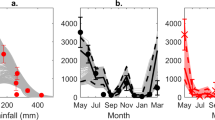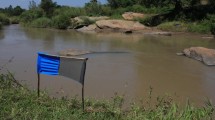Abstract
The elimination of river blindness (onchocerciasis) in West Africa has been one of the most successful public health and economic development programs yet conducted. Control was based on aerial application of insecticides to control the aquatic, larval stages of black flies in the Simulium damnosum complex and distribution of ivermectin-based drugs to reduce incidence of the filarial worm, Onchocerca volvulus, that may ultimately result in blindness. Control efforts were long-term (1974–2003), extensive (with as many as 50,000 km of river miles being treated weekly for 12 years or longer), and far-reaching (distribution of drugs to almost 7 million people in 11 West African countries). The challenges and success of the program were strongly related to biodiversity: the vector S. damnosum is actually a complex of several species and subspecies, which vary in their competence in disease transmission; the filarial worm O. volvulus has different forms that vary in their virulence and incidence of producing blindness in humans; maintenance of the biodiversity of the non-target riverine fauna was a prime concern of both the control program and the donor countries that supported it; the main insecticide used to control the black fly vector was derived from a bacterium Bacillus thuringensis israelensis; and the drug used in controlling the filarial worm was derived from a soil-dwelling Streptomyces fungus. Long-term biomonitoring studies indicate that environmental damage (e.g., loss of sensitive taxa) incurred was reversed when insecticide applications ceased.






Similar content being viewed by others
References
MA Aziz S Diallo IM Diop M Larivière M Porta (1982) ArticleTitleEfficacy and tolerance of ivermectin in human onchocerciasis Lancet 2 171–173
RHA Baker P Guillet A Sékétéli P Poudiougou D Boakye MD Wilson et al. (1990) ArticleTitleProgress in controlling the reinvasion of windbourne vectors into the western area of the Onchocerciasis Control Programme in West Africa Philosophical Transactions of the Royal Society of London Series B: Biological Sciences (London) 328 731–750
B Benton J Bump A Sékétéli B Leise (2002) ArticleTitlePartnership and promise: evolution of the African river-blindness campaigns Annals of Tropical Medicine and Parasitology 96 (Suppl 1) S5–S14
DA Boakye RJ Post FW Mosha DP Surtees RHA Baker (1993) ArticleTitleCytotaxonomic revision of the Simulium sanctipauli subcomplex (Diptera: Simuliidae) in Guinea and the adjacent countries including descriptions of two new species Bulletin of Entomological Researches 83 171–186
B Boatin DH Molyneux JM Hougard OW Christensen ES Alley L Yaméogo et al. (1997) ArticleTitlePatterns of epidemiology and control of onchocerciasis in West Africa Journal of Helminthology 71 91–101
M Boisvert J Boisvert (2000) ArticleTitleEffects of Bacillus thuringensis var. israelensis on target and non-target organisms: a review of laboratory and field experiments Biocontrol Science and Technology 10 517–561
D Calamari L Yaméogo J-M Hougard C Lévêque (1998) ArticleTitleEnvironmental assessment of larvicide use in the Onchocerciasis Control Programme Parasitology Today 14 485–489
C Costantini NF Sagnon A Torre Particledella M Coluzzi (1999) ArticleTitleMosquito behavioural aspects of vector-human interactions in the Anopheles gambiae complex Parassitologia 41 209–217
KY Dadzie J Remme G De Sole B Boatin ES Alley O Ba et al. (1991) ArticleTitleOnchocerciasis control by large-scale ivermectin treatment Lancet 337 1358–1359
KY Dadzie G De Sole J Remme (1992) ArticleTitleOccular onchocerciasis and the intensity of infection in the community. IV. The degraded forest of Sierra Leone Tropical Medicine and Parasitology 43 75–79
JB Davies (1994) ArticleTitleSixty years of onchocerciasis vector control: a chronological summary with comments on eradication, reinvasion, and insecticide resistance Annual Review of Entomology 39 23–45
D de Clerc J Vercruysse M Sene I Seek CSM Sall A Ly et al. (2000) ArticleTitleThe effects of irrigated agriculture on the transmission of urinary schistosomiasis in the middle and upper valleys of the Senegal River basin Annals of Tropical Medicine and Parasitology 94 581–590
BOL Duke J Anderson (1972) ArticleTitleA comparison of the lesions produced in the corena of the rabbit eye by microfilariae of the forest and Sudan savanna strains of Ohchocerca volvulus from Cameroon. I. The clinical picture Tropenmedizin Parasitologie 23 354–368
BOL Duke DJ Lewis PJ Moore (1966) ArticleTitleOnchocerca Simulium complexes. I. Transmission of forest and Sudan savanna strains of Onchocerca volvulus, from Cameroon, by Simulium damnosum from various West African bioclimatic zones Annals of Tropical Medicine and Parasitology 60 318–336
Ejere H, Schwartz E, Wormald R (2001) Ivermectin for onchocercal eye disease (river blindness). Cochrane Database System Review 1:CD002219
KD Erttman TR Unnasch BM Greene EJ Albiez J Boateng AM Denke et al. (1987) ArticleTitleA DNA sequence specific for forest form Onchocerca volvulus Nature 327 415–417
R Garms JF Walsh JB Davies (1979) ArticleTitleStudies on the reinvasion of the Onchocerciasis Control Programme in the Volta River basin by Simulium damnosum s.l. with emphasis on the south western areas Tropenmedizin und Parasitologie 30 345–362
LJ Goldberg J Margalit (1977) ArticleTitleA bacterial spore demonstrating rapid larvicidal activity against Anopheles sergentii, Uranotaemia unguiculata, Culex univittatus, Aedes aegypti and Culex pipiens Mosquito News 37 355–358
IF Grant (2001) ArticleTitleInsecticides for tsetse and trypanosomiasis control: is the environmental risk acceptable? Trends in Parasitology 17 10–14
P Guillet H Escaffre M Ouédraogo D Quilévéré (1980) ArticleTitleMise en évidence d’une résistance au téméphos dans le complexe S. damnosum (S. sanctipauli et S. soubrense) en Côte d’lvoire (zone du programme de lutte contre l’onchocercose dans la region du basin de la Volta) Cahiers ORSTOM, Série Entomogie Médicale et Parasitologie 23 291–299
JM Hellawell (1978) Biological Surveillance of Rivers: a Biological Monitoring Handbook Water Research Center Medmenham, UK
JM Hougard P Poudiougo P Guillet C Back LK Akpoboua D Quillevere (1993) ArticleTitleCriteria for the selection of larvicides by the Onchocerciasis Control Programme in west Africa Annals of Tropical Medicine and Parasitology 87 435–442
J-M Hougard L Yaméogo A Sékétéli B Boatin KY Dadzie (1997) ArticleTitleTwenty-five years of blackfly control in the Onchocerciasis Control Programme in West Africa Parasitology Today 13 425–431
J-M Hougard ES Alley L Yaméogo KY Dadzie BA Boatin (2001) ArticleTitleEliminating onchocerciasis after 14 years of vector control: a proved strategy The Journal of Infectious Diseases 184 497–503
HBN Hynes (1970) The Ecology of Running Waters University of Toronto Press Toronto
DC Kurtak H Jamnback R Meyer M Ocran P Penaud (1987) ArticleTitleEvaluation of larvicides for the control of Simulium damnosum s.l. (Diptera: Simuliidae) in West Africa Journal of the American Mosquito and Control Association 3 201–210
C Lévêque J-M Hougard V Resh B Statzner L Yaméogo (2003) ArticleTitleFreshwater biodiversity in the tropics: what did we learn from 30 years of onchocerciasis control and the associated biomonitoring of West African rivers Hydrobiologia 500 1–23
DH Molyneux (1995) ArticleTitleOnchocerciasis control in West Africa: current status and future of Onchocerciasis Control Programme Parasitology Today 11 399–402
DH Molyneux C Morel (1998) ArticleTitleOnchocerciasis and Chagas’ disease control: the evolution of control via applied research through changing development scenarios British Medical Bulletin 54 327–339
A Moncayo (1999) ArticleTitleProgress towards interruption of transmission of Chagas disease Memorias do Instituto Oswaldo Cruz, Rio de Janeiro 94 401–404
D Paugy Y Fermon KE Abban E Diop K Traoré (1999) ArticleTitleOnchocerciasis Control Programme in West Africa: a 20-year monitoring of fish assemblages Aquatic Living Resources 12 363–378
M Picquet JC Ernould J Vercruysse SouthgateVR A Mbaye B Sambou et al. (1996) ArticleTitleThe epidemiology of human schitosomiasis in the Senegal River basin Transactions of the Royal Society of Tropical Medicine and Hygiene 90 340–346
JR Powell V Petrarca A Torre Particledella A Caccone M Coluzzi (1999) ArticleTitlePopulation structure, speciation, and introgression in the Anopheles gambiae complex Parasitologia 41 101–113
JHF Remme (1995) ArticleTitleThe African Programme for Onchocerciasis Control: preparing to launch Parasitology Today 11 403–406
JHF Remme O Ba JY Dadzie M Karam (1986) ArticleTitleA force-of-infection model for onchocerciasis and its applications in the epidemiological evaluation of the Onchocerciasis Control Programme in the Volta River basin area Bulletin of the World Health Organization 64 667–681
VH Resh (1995) Use of freshwater benthic macroinvertebrates and rapid assessment procedures in developing and newly industrialized countries WS Davis TP Simon (Eds) Biologicals Assessment and Criteria: Tools for Water Resource Planning and Decision Making Lewis Publishers Boca Raton, FL 161–177
VH Resh JK Jackson (1993) Rapid assessment approaches to biomonitoring using benthic macroinvertebrates DM Rosenberg VH Resh (Eds) Freshwater Biomonitoring and Benthic Macroinvertebrates Chapman and Hall New York 195–233
VH Resh C Lévêque B Statzner (2004) ArticleTitleLong-term, large-scale biomonitoring of the unknown: assessing the effects of insecticides to control river blindness (onchocerciais) in West Africa Annual Review of Entomology 49 115–139
FO Richards B Boatin M Sauerbrey A Sékétéli (2001) ArticleTitleControl of onchocerciasis today: status and challenges Trends in Parasitology 17 558–563
EM Samba (1994) The Onchocerciasis Control Programme in West Africa. An Example of Effective Public Health Management World Health Organization Geneva
MW Service H Townson (2002) The Anopheles vector DA Warrell HM Gilles (Eds) Essential Malariology Arnold London 59–84
VR Southgate D Clercq Particlede M Sene D Rollinson J Vercruysse (2000) ArticleTitleObservations on the compatibility between Bulinus spp and Schistosoma haematobium in the Senegal River basin Annals of Tropical Medicine and Parasitology 94 157–164
J Tang L Toe C Back PA Zimmerman K Pruess TR Unnasch (1995) ArticleTitleThe Simulium damnosum species complex: phylogenetic analysis and molecular identification based upon mitochondrially encoded gene sequences Insect Molecular Biology 4 79–88
L Toe A Merriweather TR Unnasch (1994) ArticleTitleDNA probe-based classification of Simulium damnosum s.l.-borne and human-derived filarial parasites in the onchocerciasis control program area American Journal of Tropical Medicine and Hygiene 51 676–683
L Toe J Tang C Back CR Katholi TR Unnasch (1997) ArticleTitleVector-parasite transmission complexes for onchocerciasis in West Africa Lancet 349 163–166
YT Touré B Petrarca SF Traore A Coulibaly HM Maiga O Sankare et al. (1994) ArticleTitleEcological genetic studies in the chromosomal form Mopti of Anopheles gambiae s. str. in Mali, West Africa Genetica 94 213–223
JF Walsh JB Davies R LeBerre R Garms (1978) ArticleTitleStandardisation of criteria for assessing the effect of Simulium control in onchocerciasis control programmes Transactions of the Royal Society of Tropical Medicine and Hygiene 72 675–676
InstitutionalAuthorName World Health Organization (WHO) (1995) Onchocerciasis and Its Control: Report of a WHO Expert Committee on Onchocerciasis Control WHO Technical Report Series No. 852, Geneva World Health Organization
InstitutionalAuthorNameWorld Health Organization (WHO) (2002) Preserving the Environment: a Major OCP Concern over Past Twenty-five Years World Health Organization Geneva
L Yaméogo J-M Tapsoba D Calamari (1991) ArticleTitleLaboratory toxicity of potential blackfly larvicides on some African fish species in the Onchocerciasis Control Programme area Ecotoxicology and Environmental Safety 21 248–256
L Yaméogo J-M Elouard M Simier (1992) ArticleTitleTypology of susceptibilities of aquatic insect larvae to different larvicides in a tropical environment Chemosphere 24 2009–2020
L Yaméogo G Crosa Sammon K Nabé D Tholley D Calamari (2001) ArticleTitleLong-term assessment of insecticide treatments in West Africa: aquatic entomofauna Chemosphere 44 1759–1773
PA Zimmerman KY Dadzie G De Sole J Remme ES Alley TR Unnasch et al. (1992) ArticleTitleOnchocerca volvulus DNA probe classification correlates with epidemiologic patterns of blindness Journal of Infectious Diseases 165 964–968
Author information
Authors and Affiliations
Corresponding author
Rights and permissions
About this article
Cite this article
Yaméogo, L., Resh, V. & Molyneux, D. Control of River Blindness in West Africa: Case History of Biodiversity in a Disease Control Program. EcoHealth 1, 172–183 (2004). https://doi.org/10.1007/s10393-004-0016-7
Published:
Issue Date:
DOI: https://doi.org/10.1007/s10393-004-0016-7




